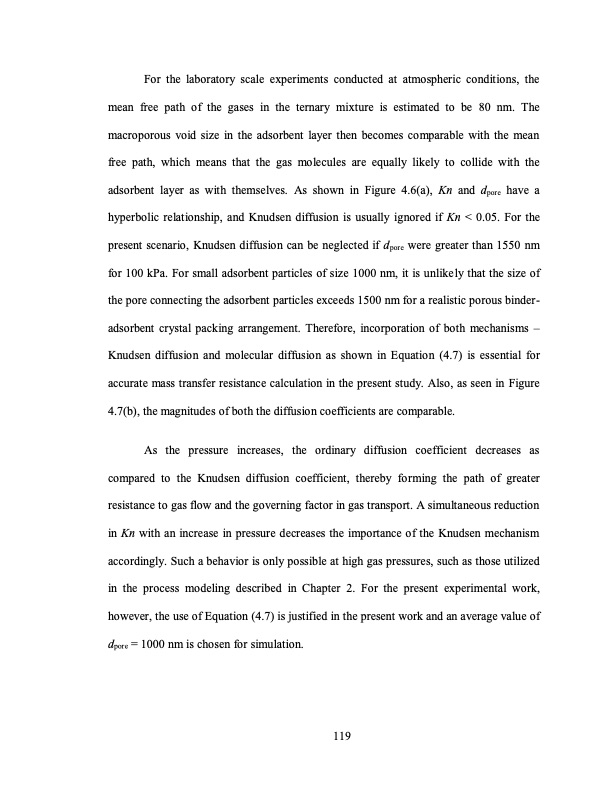
PDF Publication Title:
Text from PDF Page: 146
For the laboratory scale experiments conducted at atmospheric conditions, the mean free path of the gases in the ternary mixture is estimated to be 80 nm. The macroporous void size in the adsorbent layer then becomes comparable with the mean free path, which means that the gas molecules are equally likely to collide with the adsorbent layer as with themselves. As shown in Figure 4.6(a), Kn and dpore have a hyperbolic relationship, and Knudsen diffusion is usually ignored if Kn < 0.05. For the present scenario, Knudsen diffusion can be neglected if dpore were greater than 1550 nm for 100 kPa. For small adsorbent particles of size 1000 nm, it is unlikely that the size of the pore connecting the adsorbent particles exceeds 1500 nm for a realistic porous binder- adsorbent crystal packing arrangement. Therefore, incorporation of both mechanisms – Knudsen diffusion and molecular diffusion as shown in Equation (4.7) is essential for accurate mass transfer resistance calculation in the present study. Also, as seen in Figure 4.7(b), the magnitudes of both the diffusion coefficients are comparable. As the pressure increases, the ordinary diffusion coefficient decreases as compared to the Knudsen diffusion coefficient, thereby forming the path of greater resistance to gas flow and the governing factor in gas transport. A simultaneous reduction in Kn with an increase in pressure decreases the importance of the Knudsen mechanism accordingly. Such a behavior is only possible at high gas pressures, such as those utilized in the process modeling described in Chapter 2. For the present experimental work, however, the use of Equation (4.7) is justified in the present work and an average value of dpore = 1000 nm is chosen for simulation. 119PDF Image | TEMPERATURE SWING ADSORPTION PROCESSES FOR GAS SEPARATION

PDF Search Title:
TEMPERATURE SWING ADSORPTION PROCESSES FOR GAS SEPARATIONOriginal File Name Searched:
PAHINKAR-DISSERTATION-2016.pdfDIY PDF Search: Google It | Yahoo | Bing
CO2 Organic Rankine Cycle Experimenter Platform The supercritical CO2 phase change system is both a heat pump and organic rankine cycle which can be used for those purposes and as a supercritical extractor for advanced subcritical and supercritical extraction technology. Uses include producing nanoparticles, precious metal CO2 extraction, lithium battery recycling, and other applications... More Info
Heat Pumps CO2 ORC Heat Pump System Platform More Info
| CONTACT TEL: 608-238-6001 Email: greg@infinityturbine.com | RSS | AMP |